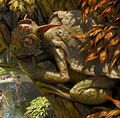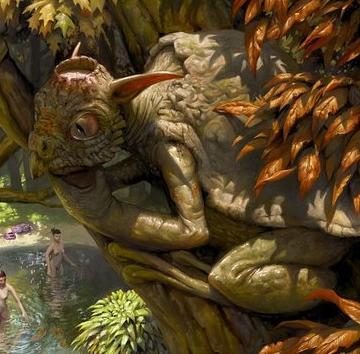Kappa.jpg (360 × 354 pixels, file size: 29 KB, MIME type: image/jpeg)
Kappa (河童?, "river-child"), alternately called Kawatarō (川太郎?, "river-boy") or Kawako (川子?, "river-child"), are legendary creatures; a type of water sprite found in Japanese folklore. However they are also considered to be a part of cryptozoology, due to claims of sightings. In Shintō they are considered to be one of many suijin. A hair-covered variation of a Kappa is called a Hyōsube (ひょうすべ?).
Most depictions show kappa as child-sized humanoids, though their bodies are often more like those of monkeys or frogs than human beings. Kappa smell like fish and are generally portrayed with the body of a tortoise, ape-like head, scaly limbs, long hair circling the skull, webbed feet and hands, and yellow-green skin. They are often depicted with a tortoise shell attached to their backs. Some say they can change color like the chameleon. They abhor metal objects and loud noises (cannon fire, gunfire, etc.).
The defining characteristic of the Kappa is the hollow cavity atop its head. This saucer-like depression holds a strength-giving fluid. Should you chance upon the quarrelsome Kappa, please remember to bow deeply. If the courteous Kappa bows in return, it will spill its strength-giving water, making it feeble, and forcing it to return to its water kingdom.
About the size of a child aged 6 to 10, the Kappa is nonetheless incredibly strong. It attacks horses, cattle, and humans, usually dragging its prey into the water, where, according to various legends, it feeds on their blood, or drains their life force, or pulls out their livers through their anuses, or sucks out their entrails, leaving nothing behind except a hollow gourd. Stories tell of Kappa pulling little children into the water and drowning them. In many localities, drowning is still referred to as GAPPADOKO (ガーッパドコ). As drowning victims were sometimes found with a distended anus (swollen rectal), the Kappa is also sometimes called the shirokodama (anus) vampire. In some tales, the Kappa is associated with theft and raping women.
Kappa are mostly evil, but not always. When benevolent, the Kappa is supposedly a skilled teacher in the art of bone setting and other medical skills. In the real world of medicine, the term "kappa" refers to a monoclonal plasma cell related to bone marrow. (Note: Not yet able to confirm Kappa's bone-setting skills; but sounds very plausible, as most Shinto "kami" have some redeeming qualities.) In addition, the Kappa is always portrayed as trustworthy despite its many evil ways. When captured and forced to promise never again to harm anyone, the kappa always keeps its promise. Kappa often help or mentor those who outwit them or capture them.
File history
Click on a date/time to view the file as it appeared at that time.
| Date/Time | Thumbnail | Dimensions | User | Comment | |
|---|---|---|---|---|---|
| current | 02:42, 28 May 2009 |  | 360 × 354 (29 KB) | Aaabc (talk | contribs) | Kappa (河童?, "river-child"), alternately called Kawatarō (川太郎?, "river-boy") or Kawako (川子?, "river-child"), are legendary creatures; a type of water sprite found in Japanese folklore. However they are also considered to be a part of cryptoz |
You cannot overwrite this file.
File usage
There are no pages that use this file.

